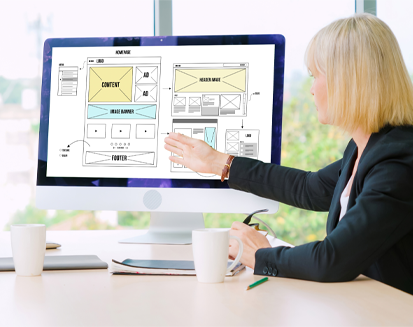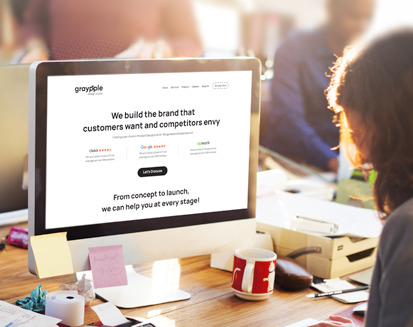Do you need clarification about what makes UX design different from UI design? It’s not just you. Although they have much in common, these terms relate to different design parts. It’s simple to confuse one for the other while using digital items. When is UI design necessary, and when is UX design sufficient?

To better grasp these crucial aspects of digital product development, we’ll present a clear and detailed summary of the differences between UI and UX design in this blog.
What is UI?
Regarding websites, apps, and other digital goods, the User Interface (UI) is critical to the design process. User Interface design, in its most fundamental form, is concerned with creating the digital product’s visual and interactive aspects and components. The goal is to design a user-friendly digital space that looks good and is easy to navigate. Although user interface design (UI) may first be concerned with visual appeal, its true purpose is to ensure that every one of a product’s users has a positive and memorable experience.
What are the features of UI?
- Making visual designs for products: User interface designers create the visual style of a software or app. They all choose the layout, fonts, images, and more. A product’s aesthetic attractiveness is primarily determined by the UI designer’s choices, such as whether to employ smooth gradients to generate a feeling of serenity or accent components to capture attention.
- Attracting Visitors: Keeping people interested and returning is always challenging in the vast online world. The user interface design makes the product seem appealing and welcoming. Visuals are a powerful tool in attracting visitors to any website, whether a blog, a financial institution, or an online retailer. Accessible and engaging user interfaces make even the most complicated information more accessible to understand and use.
- Intuitive Design: An effective user interface may make people feel a certain way. The degree to which a product evokes a certain feeling might change based on its intended use. While a vacation site may want to pique users’ interest, a meditation app may work to promote calm. To make their products more memorable and shareable, UI designers use many psychological techniques, including the intentional use of color, imagery, and layout.
What Does a UI Designer Do: Tasks and Responsibilities?
There is much more to being a UI designer than just making things seem nice. They are crucial in ensuring a digital product appears good and works well. Essential duties of a user interface designer include:
- Creating User-Facing Elements: Designers of user interfaces are the ones that make the pages and displays that people utilize. Positioning controls like buttons, sliders, blocks, and switches is essential to this process.
- Maintaining Brand Consistency: Maintaining coherence in branding efforts is essential. Designers of user interfaces ensure all visuals are consistent with the company’s branding standards. This regularity inspires confidence and familiarity among users.
- Making a Design Manual: The visual aspects of a product are generally documented in a design manual written by the product’s user interface designer. Thanks to this guide outlining those decisions in detail, the digital output will share the same colors, fonts, and images.
- Product Polishing: Designers working on user interfaces always try to improve the app’s aesthetic. To improve the user interface in response to user input and new design trends, they collaborate with UX (User Experience) designers and developers.
What is the Importance of UI ?
Why is user interface design so crucial? The explanation may be found in the fact that it directly affects how a user interprets and uses a digital product. Imagine you want to buy something that doesn’t exist in natural form, like flower delivery. The user cannot judge the product by its outward look or practicality, as they might with a physical product like a phone. Instead, the website’s informational prowess is the deciding factor in making a sale.
The likelihood of a purchase is boosted by a well-executed user interface design. It streamlines complicated data, provides consumers with straightforward direction, and makes them feel good. Customers are more inclined to buy anything that satisfies their requirements and provides them with a fun and satisfying experience.
What is UX?
When it comes to the success or failure of a digital product, User Experience (UX) is the most critical factor. While UI designers are concerned with the product’s look and feel, UX experts ensure that the consumer experiences nothing but ease, joy, and significance from every interaction with the product. User experience design is the key to unlocking the user’s innermost feelings, drives, and contentment degrees. What matters most is how the product makes its users feel and interact with it.
What are UX’s Primary features?
- Studying Human Interactions: Research is the first step in the UX design process. Understanding the user’s wants and problems is a top priority for designers. They look at what the competition offers, determine what works and what doesn’t, and investigate the benefits and drawbacks of the available options. Making and testing prototypes at this stage helps designers remove inefficient options.
- Working with Structure: User behavior analysis is a vital part of user experience design. Designers closely examine how people use a website or an app. They track how often people click on certain links, where they go for specific information, and what people expect from websites. Based on this information, the product may be designed to meet the needs of its target audience.
- Ensuring User Convenience: The results of careful cooperation and in-depth analytics provide a well-designed user experience. Decisions must be made that consider user requirements while supporting organizational objectives. Ensuring every part of the user experience is practical and user-friendly is vital since poor UX design may turn people away from a product.
What does a UX Designer Do?
A user experience designer’s work is crucial to any digital product’s success. Their roles are diverse, but they all serve to improve the user’s overall experience:
- Researching the Target Audience: UX designers start with a solid foundation of research about the intended demographic. Personas, fictional representations of a certain kind of user, are developed by this group. Every design choice should stem from an intimate familiarity with the user and their needs.
- Making strategic decisions: Every decision a UX designer makes must be backed up by solid reasoning. They lay forth a well-thought-out plan that addresses the “why” questions raised by design choices at every level. This guarantees that the product is aesthetically pleasing and has a practical function.
- Prototyping: Designers focusing on user experience build the framework for a product by drawing out wireframes and imagining different use cases. They visually represent ideas, revealing to all parties involved how the final product will look, feel, and operate. Refining and perfecting the user’s path requires prototyping.
UI vs UX: Differences
01. Focus and Emphasis
- UI: When designing a user interface, aesthetics and functionality are prioritized equally. It emphasizes the aesthetic aspects of a digital product to attract customers and provide them with a pleasant experience.
- UX: User experience design, on the other hand, focuses on the user’s actions and how they engage with the product as a whole. It cares about how people experience using the product and strives to streamline and simplify the process.
02. Purpose
- UI: The goal of any suitable user interface (UI) is to make using the product a pleasurable experience. The emphasis is on the visual aspects of design, such as color, typeface, image, and layout.
- UX: The primary focus of user experience (UX) design is on the product’s practicality and efficiency in use. The goal is to provide a satisfying experience for the consumer by making the product simple to use.
03. Technical vs. Artistic
- UI: Designing a UI is frequently more of an aesthetic endeavor. Designers must apply their imagination to create a visually appealing interface that draws in consumers.
- UX: User experience design is more technical and analytical. To improve the user experience, designers examine user patterns, perform experiments, and develop working prototypes.
04. Prototyping and Evaluation
- UI: The user interface (UI) designers primarily emphasize the product’s visual component. However, they may construct prototypes to conceptualize the layout and aesthetics.
- UX: Prototyping and in-depth study of user behavior are two tools that are essential to UX designers. They produce wireframes and interactive prototypes to evaluate and improve the user flow.
05. User Interaction
- UI: User interface (UI) design focuses on the parts of a product that end users touch and utilize. It guarantees the aesthetic and functional quality of these components.
- UX: When designing for the user experience, it’s essential to think about what they’ll go through from the time they first see the product until they’ve accomplished their objective. Interactional flow and user happiness are the primary design goals.
06. Balancing Functionality and Aesthetics
- UI: An exemplary user interface designer aims to combine attractiveness with functionality. They guarantee that the visual aspects improve the product’s utility and aesthetic appeal.
- UX: UX designers put the user’s needs first, regardless of the design’s appearance. One of their main objectives is to make the product as user-friendly as possible.
How can UI and UX Work Together Seamlessly?
UI and UX designers can work together quickly if they talk and always work together during the design and development process. How they may work together productively is as follows:
- Early Collaboration: Designers for the user interface and user experience should work together from the start. This permits a comprehensive method of product creation since both the visual design and the user experience are considered.
- Expected Goals: The project’s aims and objectives should be clear to both groups. This harmony facilitates design choices that give equal weight to form and function (UI/UX).
- Continuous Feedback: Feedback on the practicality and usefulness of the visual aspects may be provided to UX designers by UI designers. Similarly, UX designers may shed light on how specific design decisions affect the end user’s journey.
- Iterative Method: Iterative testing and feedback loops are essential to a successful design process. User experience designers may perform usability tests to pinpoint problem areas, allowing user interface designers to hone down on aesthetics.
- Flexibility: Both groups need to be flexible as the project develops. Once UX designers have determined the optimal location or functionality, UI designers may adjust the graphics to match.
- Prototyping: Prototyping in tandem with a team is helpful. While UI designers may work on visual prototypes to polish the aesthetics, UX designers can construct interactive prototypes to evaluate user flows. This facilitates a coordinated method of creation.
Conclusion
Making remarkable products requires UI and UX to work together. UX guarantees smooth interactions, while UI impresses with its visuals. These two halves of the plan must work together, bridging the gap between aesthetics and utility. UI’s eye-catching graphics and UX’s user-centered approach make for a successful digital product.
Are you looking for professional UI/UX services? Graypple Design Studio is one of the best UI/UX design agencies with years of experience serving clients from various industries. Share your design requirements with us and create a visually appealing and intuitive digital presence for your business.
FAQs
How do UI and UX design vary from each other?
While User Interface design is concerned with how a product looks and feels, User Experience design is concerned with how a product is used.
For what reasons is it essential for UI and UX designers to work together?
By working together, creators can guarantee that their digital product is aesthetically pleasing, simple to use, and effective.
How do you get UI and UX designers to work well together?
Digital experiences that are coherent are the result of early collaboration, shared objectives, consistent feedback, and an iterative design approach.


